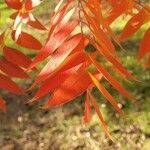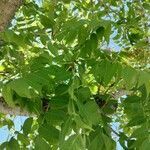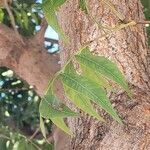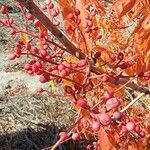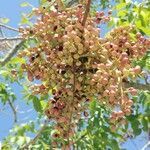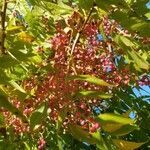Tree up to 26 m tall and 1 m Ø, sometimes with buttresses. Bark light brownish, scaly. Leaves with (3-)5-6(-10) pairs of leaflets (terminal leaflet sometimes absent), up to 20 cm long; rachis and petiole puberulous, glabrescent; petiole up to 7 cm. Leaflets subsessile or sessile, chartaceous, lanceolate, 4-8 by 1-2½ cm, puberulous beneath, glabrescent; base cuneate; apex acuminate; nerves 10-14 pairs, distinct; veins reticulate. Inflorescences racemose in ♂, paniculate in ♀, up to 8 cm long, puberulous, glabrescent; bracts lanceolate, c. 1 mm long; pedicels 1-2 mm. Tepals 2-5, elliptic, 1-1½ mm long. Stamens 3-5, ¾ mm; filaments very short; anthers ellipsoid or oblong, c. 1 mm, slightly apiculate. Disk 0. Ovary globose, ⅔ mm Ø; style ½ mm long; stigmas c. ½ mm long; sterile pistil in ♂ minute. Drupe globose, ⅓-½ cm Ø, slightly compressed, red changing to greenish blue when ripe.
A large tree which loses its leaves. It grows 8-25 m high and spreads 4.5 m wide. The trunk can be 1 m across. It can have small buttresses. The leaves have leaflets along the stalk. There are 10-12 leathery leaflets which are dark green. They turn yellow or orange in the autumn. The flowers are small and near the ends of shoots. They are reddish. The fruit are reddish or bluish berries.
Pending. See Rodd (1996: 343), Harden (2002: 334).
